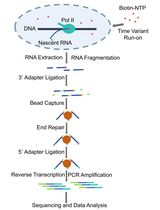- EN - English
- CN - 中文
Plasmid and Sequencing Library Preparation for CRISPRi Barcoded Expression Reporter Sequencing (CiBER-seq) in Saccharomyces cerevisiae
用于酿酒酵母中 CRISPRi 条形码表达报告基因测序 (CiBER-seq) 的质粒和测序文库制备
发布: 2022年04月05日第12卷第7期 DOI: 10.21769/BioProtoc.4376 浏览次数: 3296
评审: Dennis J NürnbergUte Angelika HoffmannAnonymous reviewer(s)
Abstract
Genetic networks regulate nearly all biological processes, including cellular differentiation, homeostasis, and immune responses. Determining the precise role of each gene within a regulatory network can explain its overall, integrated function, and pinpoint mechanisms underlying misregulation in disease states. Transcriptional reporter assays are a useful tool for dissecting these genetic networks, because they link a molecular process to a measurable readout, such as the expression of a fluorescent protein. Here, we introduce a new technique that uses expressed RNA barcodes as reporters, to measure transcriptional changes induced by CRISPRi-mediated genetic perturbation across a diverse, genome-wide library of guide RNAs. We describe an exemplary reporter based on the promoter that drives His4 expression in these guidelines, which can be used as a framework to interrogate other expression phenotypes. In this workflow, a library of plasmids is assembled, encoding a CRISPRi guide RNA (gRNA) along with one or more transcriptional reporters that drive expression of guide-specific nucleotide barcode sequences. For example, when interrogating regulation of the budding yeast HIS4 promoter normalized against a control housekeeping promoter that drives Pgk1 expression, this plasmid library contains a gRNA expression cassette, a HIS4 reporter driving expression of one gRNA-specific nucleotide barcode, and a PGK1 reporter driving expression of a second, gRNA-specific barcode. Long-read sequencing is used to determine which gRNA is associated with these nucleotide barcodes. The plasmid library is then transformed into yeast cells, where each cell receives one plasmid, and experiences a genetic perturbation driven by the guide on that plasmid. The expressed RNA barcodes are extracted in bulk and quantified using high-throughput sequencing, thereby measuring the effect of their corresponding gRNA on barcoded reporter expression. In the case of the HIS4 reporter described above, guides disrupting translation elongation will increase expression of the associated HIS4 barcode specifically, without changing expression of the PGK1 control barcode. It is further possible to quantify plasmid abundance by DNA sequencing, as an additional approach to normalize for differences in plasmid abundance within the population of cells. This protocol outlines the steps to prepare barcode reporter CRISPRi plasmid libraries, link guides to barcodes with long-read sequencing, and measure expression changes through barcode RNA and DNA sequencing. This method is ideal for probing transcriptional or post-transcriptional regulation, as it measures the effects of a genetic perturbation by directly quantifying reporter RNA abundance, rather than relying on indirect growth or fluorescence readouts.
Graphic abstract:

Background
By systematically measuring quantitative phenotypes across a library of gene perturbations, one can build a picture of the regulatory landscape of the cell. The advent of CRISPR technology simplifies the process of systematic genetic perturbation (Cong et al., 2013; Jinek et al., 2013), which can be combined with a molecular phenotypic reporter to understand regulation of that reporter across a diverse library of genetic backgrounds (Gilbert et al., 2013). Previous methods have measured transcriptional phenotypes, by coupling changes in transcription to either changes in cellular growth, or changes in fluorescent protein expression (Kampmann, 2020). However, because cellular growth and fluorescence are indirect readouts of underlying transcriptional regulation, genetic perturbations unrelated to the underlying transcriptional control can nevertheless affect reporter expression. The expression of barcoded RNAs provides a more direct means of quantifying transcriptional changes (Muller et al., 2020; Alford et al., 2021). Furthermore, RNA barcodes can be quantified from bulk extraction and sequencing, which avoids bottlenecks that occur as a result of cell sorting, and is thus more scalable than traditional fluorescence-activated cell sorting (FACS) approaches. In addition to encoding the unique identity of the gRNA, the expressed barcodes can also encode reporter-specific tags, allowing for multiplexed screens in a single experiment.
RNA barcodes can be used to interrogate additional biological questions beyond transcriptional regulation. For example, RNA stability and splicing phenotypes, which impact the abundance of specific RNA isoforms, can be interrogated by comparing a query reporter against a suitable control that normalizes for transcriptional effects. Nonsense-mediated mRNA decay, which acts on specific splice isoforms that contain premature stop codons, can be interrogated in this manner. By driving barcode expression with two reporters that differ only by the presence or absence of a premature stop codon, one can ignore transcriptional effects and identify factors that specifically affect mRNA isoform stability. With some adaptations to the technique, RNA barcodes can be used to study other RNA-centric processes, including RNA modifications, interactions, and localization. Interrogating these processes may require additional enrichment steps to recapitulate the phenotype of interest. Interrogating nuclear localization of certain mRNAs, for example, would combine a nuclear isolation protocol with the barcode expression profiling detailed in these protocols. A barcoded-RNA readout can also be linked to other versions of CRISPR-mediated genetic perturbation, including CRISPR activation (CRISPRa) for targeted gene expression, or nucleolytically active CRISPR for targeted gene mutations (Cong et al., 2013; Gilbert et al., 2013; Jinek et al., 2013). Finally, by adapting an orthogonal transcription factor to drive RNA barcode expression, it is possible to extend this barcode sequencing approach to interrogate questions in protein stability and translation regulation (Aranda-Díaz et al. 2017). This approach has previously been used to understand Gcn4 protein degradation by fusing the GCN4 coding sequence in frame with an orthogonal transcription factor and monitoring barcode expression of a reporter driven by said transcription factor (Muller et al., 2020).
Materials and Reagents
Note: All reagents can be stored at room temperature unless otherwise specified.
Plasmid library construction
Gene Pulser/MicroPulser Electroporation Cuvettes, 0.1 cm gap (Bio-Rad, catalog number: 1652089)
pNTI743 dual-barcoded gRNA parent vector (Addgene, catalog number: 164915), store at -20°C
pNTI757 P(PGK1)-citrine P(HIS4)-mCherry (Addgene, catalog number: 164917), store at -20°C
Custom CRISPRi gRNA oligo pool, (Custom Array Inc; ~60,000 oligo pool of 60 nucleotide oligos), store at -20°C, previously published inMcGlincy et al. (2021)
Primers for amplifying gRNA pool (IDT, 25 nmole DNA Oligo, Standard Desalting), store at -20°C
For this specific study, we used NM636: ggctgggaacgaaactctgggagctgcgattggca and NM637: gccttattttaacttgctatttctagctctaaaac
Zymo DNA clean and concentrator-5 kit (Zymo, catalog number: D4013)
Q5 polymerase (NEB, catalog number: M0491L), store at -20°C
Restriction enzymes:
AvrII (NEB, catalog number: R0174S), store at -20°C
AscI (NEB, catalog number: R0558S), store at -20°C
HindIII-HF (NEB, catalog number: R3104S), store at -20°C
PmeI (NEB, catalog number: R0560S), store at -20°C
BglII (NEB, catalog number: R0144S), store at -20°C
XhoI (NEB, catalog number: R0146S), store at -20°C
BciVi (NEB, catalog number: R0596S), store at -20°C
HiFi DNA assembly 2× master mix (NEB, catalog number: E2621L), store at -20°C
MegaX DH10B T1R ElectrocompTM Cells (Invitrogen, catalog number: C640003), store at -80°C
NEB® 10-beta Competent E. coli (High Efficiency) (NEB, catalog number: C3019H), store at -80°C
LB-carbenicillin agar plates and liquid media (50 µg/mL carbenicillin):
Luria Bertani medium capsules (MP Biomedicals, catalog number: 3002031)
Carbenicillin (Gold Bio, catalog number: C-103-5), store at -20°C
SuperPureTM Agar Bacteriological Grade Type A (US BioTech Sources, catalog number: A01PD-500)
10 cm polystyrene Petri dishes (Fisher Scientific, catalog number: 08-757-100D)
HiSpeed Midiprep kit (Qiagen, catalog number: 12643)
Monarch Plasmid Miniprep Kit (NEB, catalog number: T1010L)
T5 exonuclease (NEB, catalog number: M0663S), store at -20°C
Dual barcode oligos (IDT, 25 nmole DNA Oligo, Standard Desalting), store at -20°C
RM720:
CCACATGTGCATTGCCTCGGACACTCTTTCCCTACACGACGCTCTTCCGATCTNNNNNNNNNNNNNNNNNNNNNNNNNNCACGT GCTAACAGTGAGGCGCGRM721:
GCTCGATCCAGTCACTCTGGACACGACGCTCTTCCGATCTNNNNNNNNNNNNNNNNNNNNNNNNNNGGTAAGTGACTCGACTG GCGCGCCTCACTGTTAGCACGTG
Sanger sequencing primers (IDT, 25 nmole DNA Oligo, Standard Desalting), store at -20°C
RM377: taacatggtagttacatatactagtaatatggttcgg
KS533: gggaaacgcctggtatcttt
RM336: gttgacaatgattacaggttaaaagg
PacBio library construction for barcode-gRNA assignment
Barcoded gRNA plasmid library: Either generated from “Plasmid Library Construction” section of this protocol, or purchased from Addgene as a pooled plasmid library (Yeast Genome-wide Dual-Barcoded CRISPRi gRNA Library, Addgene #166966)
Restrictions Enzymes
HindIII-HF (NEB, catalog number: R3104S), store at -20°C
PmeI (NEB, catalog number: R0560S), store at -20°C
BglII (NEB, catalog number: R0144S), store at -20°C
XhoI (NEB, catalog number: R0146S), store at -20°C
1% agarose gel for DNA size selection and purification
Agarose LE (Gold Bio, catalog number: A-201-500)
Tris-Borate-EDTA (TBE) Buffer, 10× (National Diagnostics, catalog number: EC-860)
Zymoclean Gel DNA Recovery Kit (Zymo, catalog number: D4001)
SMRTbell Express Template Prep Kit 2.0 (Pacific Biosciences, catalog number: 100-938-900), store at -20°C
AMPure XP beads (Beckman Coulter, catalog number: A63881), store at 4 °C
Ethanol (VWR-A #TX89125-170SFU)
Nuclease-free water (Fisher Scientific, catalog number: UPW012548)
Nuclease-free microcentrifuge tubes (Ambion, catalog number: AM12450)
High Sensitivity D1000 Sample Buffer (Agilent Technologies, catalog number: 5067-5603), store at 4°C
High Sensitivity D1000 ScreenTape (Agilent Technologies, catalog number: 5067-5584), store at 4°C
High Sensitivity D1000 Ladder (Agilent Technologies, catalog number: 5067-5587), store at 4°C
Genomic DNA Reagents (Agilent Technologies, catalog number: 5067-5366), store at 4°C
Genomic DNA ScreenTape (Agilent Technologies, catalog number: 5067-5365), store at 4°C
RNA barcode sequencing library construction
PhasemakerTM Tubes (optional) (ThermoFisher Scientific, catalog number: A33248)
UltraPureTM SDS Solution, 10% (ThermoFisher Scientific, catalog number: 15553027)
Sodium Acetate 3 M pH 5.5 (Ambion, catalog number: AM9740)
EDTA 0.5 M pH 8.0 (Ambion, catalog number: AM9260G)
Phenol-chloroform-isoamyl alcohol (PCA) pH 6.6 (Ambion, catalog number: AM9730), store at 4°C
Chloroform (Fisher Chemical, catalog number: C607SK-1)
Ethanol, 100% and 70%, diluted in nuclease-free H2O (VWR-A #TX89125-170SFU)
GlycoBlue (Ambion, catalog number: AM9515), store at -20°C
Nuclease-Free Water (Fisher Scientific, catalog number: UPW012548)
Nuclease-Free Microcentrifuge Tubes (Ambion, catalog number: AM12450)
Yeast pellets from library experiment, corresponding to at least 1,000× coverage of plasmid library (at least 240 million cells if using a plasmid library containing 240,000 barcoded gRNAs), flash frozen in liquid nitrogen and stored at -80°C.
*Suggested: Harvest, pellet, and freeze (at -80°C) extra yeast pellets as back-up.
Protoscript II reverse transcriptase kit (NEB, catalog number: M0368L), store at -20°C
NEB-next dual indexing primers (NEB, catalog number: E7600S), store at -20°C
Primer-RM511: GTGACTGGAGTTCAGACGTGTGCTCTTCCGATCTTGGTCCAGTCTTGTTACCAGACAACC (IDT, 25 nmole DNA Oligo, Standard Desalting), store at -20°C
Primer-RM810: ACACTCTTTCCCTACACGACGCTCTTCCGATCT (IDT, 25 nmole DNA Oligo, Standard Desalting), store at -20°C
Primer-RM812: GTGACTGGAGTTCAGACGTGTGCTCTTCCGATCTcCGGCGCCTACAACGTCAACATC (IDT, 25 nmole DNA Oligo, Standard Desalting), store at -20°C
RNase A (Thermo Scientific, catalog number: EN0531), store at -20°C
RNase H (NEB, catalog number: M0297S), store at -20°C
Turbo DNase I (optional) (Invitrogen, catalog number: AM2238), store at -20°C
Zymo RNA clean and concentrator-25 kit (optional) (Zymo, catalog number: R1017)
Zymo DNA clean and concentrator-5 kit (Zymo, catalog number: D4013)
Q5 polymerase (NEB, catalog number: M0491L), store at -20°C
AMPure XP beads (#A63881), store at 4°C
High Sensitivity D1000 Sample Buffer (Agilent Technologies, catalog number: 5067-5603), store at 4°C
High Sensitivity D1000 ScreenTape (Agilent Technologies, catalog number: 5067-5584), store at 4°C
High Sensitivity D1000 Ladder (Agilent Technologies, catalog number: 5067-5587), store at 4°C
AE buffer (see Recipes)
DNA barcode sequencing library construction
Yeast cell pellets from library experiment, corresponding to at least 2,000× coverage of plasmid library (at least 480 million cells, if using a plasmid library containing 240,000 barcoded gRNAs), flash frozen in liquid nitrogen, and stored at -80°C.
*Suggested: Harvest, pellet, and freeze (at -80°C) extra yeast pellets as back-up.
Zymo yeast miniprep kit (Zymo, catalog number: D2004)
T7 HiScribe Kit (NEB, catalog number: E2040S), store at -20°C
Restriction Enzymes
MfeI-HF (if reporter uses citrine expression cassette) (NEB, catalog number: R3589S), store at -20°C
PvuII-HF (if reporter uses mCherry expression cassette) (NEB, catalog number: R3151S), store at -20°C
If using a custom expression cassette, choose a restriction enzyme that will linearize the plasmid library without cutting in between the T7 polymerase binding site and the annealing site for the custom designed primer referred to in material 10 of this section. See Figure 9 for a diagram of the relevant linearization and in vitro transcription steps.
Protoscript II reverse transcription kit (NEB, catalog number: M0368L), store at -20°C
NEB-next dual indexing primers (NEB, catalog number: E7600S), store at -20°C
Primer: 511DNA_IVT_RT: GTGACTGGAGTTCAGACGTGTGCTCTTCCGATCT TGGTCCAGTCTTGTTACCAGACAACC (if the reporter uses a citrine expression cassette) (IDT, 25 nmole DNA Oligo, Standard Desalting), store at -20°C
Primer: 546mcherIVT_RT: GTGACTGGAGTTCAGACGTGTGCTCTTCCGATCT TCAAGTTGGACATCACCTCCCAC (if the reporter uses an mCherry expression cassette) (IDT, 25 nmole DNA Oligo, Standard Desalting), store at -20°C
For custom barcoded ORF plasmid libraries, use a custom designed primer with 5' adapter GTGACTGGAGTTCAGACGTGTGCTCTTCCGATCT (adds the compatible priming site for the i7 NEB, catalog number: E7600S dual indexing primer), and a 3' end specific to a given ORF that will prime a reverse transcription reaction toward the random nucleotide barcode with roughly 150nt intervening sequence. (This ensures you'll have a final dual-indexed sequence that is ~300nt long, which is short enough to cluster well on the Illumina sequencer, but long enough to efficiently size select from primers and primer dimers)
RNase A (ThermoFisher, catalog number: EN0531), store at -20°C
RNase H (NEB, catalog number: M0297S), store at -20°C
Zymo DNA clean and concentrator-5 kit (Zymo, catalog number: D4013)
Zymo RNA clean and concentrator-25 kit (Zymo, catalog number: R1017)
Q5 polymerase (NEB, catalog number: M0491L), store at -20°C
AMPure XP beads (catalog number: A63881), store at 4°C
High Sensitivity D1000 Sample Buffer (Agilent Technologies, catalog number: 5067-5603), store at 4°C
High Sensitivity D1000 ScreenTape (Agilent Technologies, catalog number: 5067-5584), store at 4°C
High Sensitivity D1000 Ladder (Agilent Technologies, catalog number: 5067-5587), store at 4°C
Equipment
Plasmid library construction
Spectrophotometer (Bio-Rad, model: SmartSpecTM 3000)
Thermal cycler (Bio-Rad, model: T100TM)
ThermoMixer (Eppendorf, model: ThermoMixer C)
Incubator Shaker (New Brunswick Scientific, model: InnovaTM 4080)
4 L Pyrex Erlenmeyer flask (Corning, catalog number: F3620-4L)
14 mL polypropylene round-bottom tube (Corning, catalog number: 352059)
1.5 mL tube Centrifuge (Eppendorf, model: Centrifuge 5430)
15 and 50 mL conical tube centrifuge (Eppendorf,model: Centrifuge 5810R 15 amp version)
Stationary incubator (Thermo Scientific, model: HERATHERM Incubator)
Electroporator (Bio-Rad, model: Gene Pulser® II)
PacBio barcode-gRNA assignment
NanoDrop spectrophotometer (Thermo Scientific, model: NANODROP 2000 Spectrophotometer)
Tape Station (Agilent Technologies, model: 2200 TapeStation)
1.5 mL tube centrifuge (Eppendorf, model: Centrifuge 5430)
Gel electrophoresis rig (Thermo Scientific, model: OWL EasycastTM B1A)
DynaMagTM-2 Magnet, 1.5 mL tube magnetic rack (ThermoFisher Scientific, catalog number: 12321D)
RNA Barcode sequencing library prep
Centrifuge tube caplock clip (Benchmark Scientific, catalog number: C1005-T5-LOCK)
Thermal cycler (Bio-Rad, model: T100TM)
ThermoMixer (Eppendorf , model:ThermoMixer C)
TapeStation (Agilent Technologies, model: 2200 TapeStation)
NanoDrop (Thermo Scientific, model: NANODROP 2000 Spectrophotometer)
1.5 mL tube Centrifuge (Eppendorf, model: Centrifuge 5430)
Temperature-regulated 1.5 mL tube Centrifuge (Eppendorf, model: Centrifuge 5430R)
DNA Barcode sequencing library prep
Thermal cycler (Bio-Rad, model: T100TM)
ThermoMixer (Eppendorf, model: ThermoMixer C)
TapeStation (Agilent Technologies, model: 2200 TapeStation)
NanoDrop (Thermo Scientific, model: NANODROP 2000 Spectrophotometer)
1.5 mL tube centrifuge (Eppendorf, model: Centrifuge 5430)
Procedure
文章信息
版权信息
© 2022 The Authors; exclusive licensee Bio-protocol LLC.
如何引用
Readers should cite both the Bio-protocol article and the original research article where this protocol was used:
- Muller, R. Y., Meacham, Z. A. and Ingolia, N. T. (2022). Plasmid and Sequencing Library Preparation for CRISPRi Barcoded Expression Reporter Sequencing (CiBER-seq) in Saccharomyces cerevisiae. Bio-protocol 12(7): e4376. DOI: 10.21769/BioProtoc.4376.
- Muller, R., Meacham, Z. A., Ferguson, L. and Ingolia, N. T. (2020). CiBER-seq dissects genetic networks by quantitative CRISPRi profiling of expression phenotypes. Science 370(6522).
分类
分子生物学 > RNA > 转录
您对这篇实验方法有问题吗?
在此处发布您的问题,我们将邀请本文作者来回答。同时,我们会将您的问题发布到Bio-protocol Exchange,以便寻求社区成员的帮助。
提问指南
+ 问题描述
写下详细的问题描述,包括所有有助于他人回答您问题的信息(例如实验过程、条件和相关图像等)。
Share
Bluesky
X
Copy link













